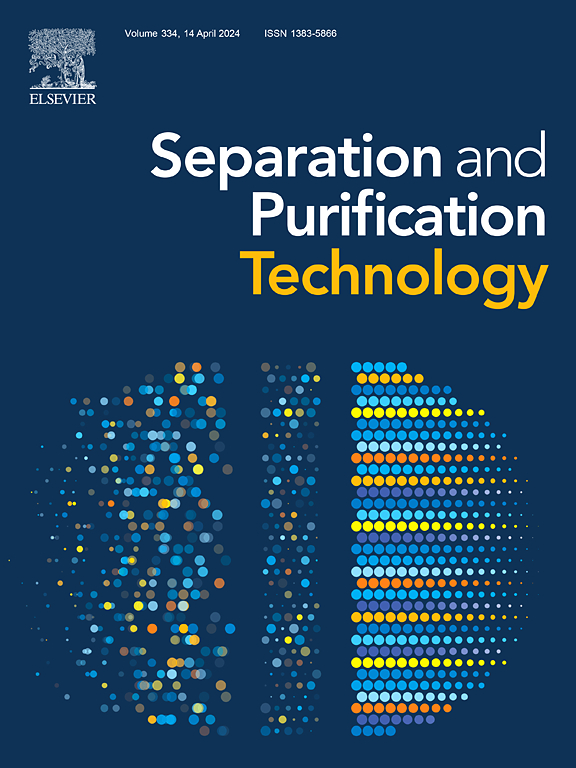利用不同的再生策略:真空、净化、加热和混合组合,对用于液化天然气生产的 X 沸石进行吸附、分离和再生的系统实验
IF 8.1
1区 工程技术
Q1 ENGINEERING, CHEMICAL
引用次数: 0
摘要
这项工作通过实验研究了两种 X 沸石在液化天然气(LNG)生产中用于天然气深度脱碳的吸附、分离和再生特性。比较了 JLOX500 和 13X 的再生特性与再生效率、能耗、二氧化碳解吸和吸附率以及真空、吹扫、加热和混合组合等不同途径中的其他因素的关系。结果表明,阳离子较多、粘合剂较少的新鲜 JLOX500 的二氧化碳吸附容量和分离因子(CO2/CH4)明显高于新鲜 13X,这是因为新鲜 13X 具有较大的微孔和较高的二氧化碳等位热。由于分压较高,证实了 CH4 与 CO2 竞争吸附对吸附剂再生的不利影响。当解吸气体中的 CO2 浓度达到零时,增加净化气体的流量对 13X 的再生效率没有影响。由于 JLOX500 具有更大的累积孔隙,因此在经过充分再生后,其 CO2 吸附能力和 CO2 解吸率均高于 13X,这也使其在净化气体和能耗利用方面更为高效。在 150 mL/min 的净化气体条件下,在 150 °C 下再生的 13X 和 JLOX500 的能耗分别为 4.20 和 2.89 MJ/kg-CO2。CH4 回收率取决于吸附剂的再生效率、吸附持续时间和使用的净化气体量。在 150°C 下通过吹扫(150 mL/min)或在 1 kPa 下抽真空再生的两种 X 沸石都能将进料中的二氧化碳含量净化到 50 ppm 以下,但就整体性能而言,JLOX500 的效率更高。本文章由计算机程序翻译,如有差异,请以英文原文为准。
Systematic experiment on adsorption, separation and regeneration of X zeolites for LNG production with different regeneration strategies: vacuum, purging, heating and hybrid combinations
This work experimentally investigated the adsorption, separation and regeneration properties of two X zeolites for natural gas deep decarbonization in liquified natural gas (LNG) production. The regeneration properties of JLOX500 and 13X were compared with relation to regeneration efficiency, energy consumption, desorption and adsorption rate of CO2, and other factors in different pathways: vacuum, purging, heating, and hybrid combinations. The results demonstrated that fresh JLOX500 with more cations and less binders had significantly greater CO2 adsorption capacities and larger separation factor (CO2/CH4) than those of fresh 13X, because of its larger micro-porosity and higher CO2 isosteric heat. Due to higher partial pressure, the adversely significant effect of CH4 competing adsorption against CO2 on adsorbent regeneration is confirmed. The flow rate increases of purge gas had no effects on regeneration efficiency for 13X when the CO2 concentration of desorbed gas reached to zero. Because of a greater cumulative pore volume, JLOX500 after sufficient regeneration has a larger CO2 adsorption capacity and a higher desorption rate of CO2 than 13X, which also makes it more efficient with regards to purge gas and energy consumption utilization. With 150 mL/min of purge gas, the energy consumptions for 13X and JLOX500 regenerated at 150 °C were 4.20 and 2.89 MJ/kg-CO2, respectively. The CH4 recovery relied on the regeneration efficiency of adsorbents, duration of adsorption, and the amount of purge gas used. Both X zeolites regenerated by purging (150 mL/min) or vacuuming at 1 kPa at 150°C could purify the feed to the CO2 content less than 50 ppm, but JLOX500 is more efficient with regards to the overall performance.
求助全文
通过发布文献求助,成功后即可免费获取论文全文。
去求助
来源期刊

Separation and Purification Technology
工程技术-工程:化工
CiteScore
14.00
自引率
12.80%
发文量
2347
审稿时长
43 days
期刊介绍:
Separation and Purification Technology is a premier journal committed to sharing innovative methods for separation and purification in chemical and environmental engineering, encompassing both homogeneous solutions and heterogeneous mixtures. Our scope includes the separation and/or purification of liquids, vapors, and gases, as well as carbon capture and separation techniques. However, it's important to note that methods solely intended for analytical purposes are not within the scope of the journal. Additionally, disciplines such as soil science, polymer science, and metallurgy fall outside the purview of Separation and Purification Technology. Join us in advancing the field of separation and purification methods for sustainable solutions in chemical and environmental engineering.
 求助内容:
求助内容: 应助结果提醒方式:
应助结果提醒方式:


